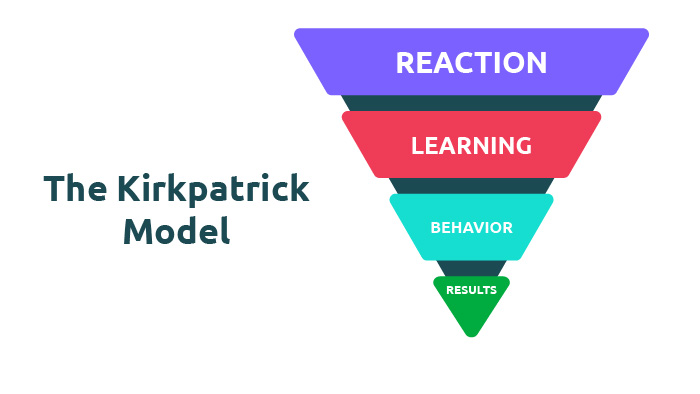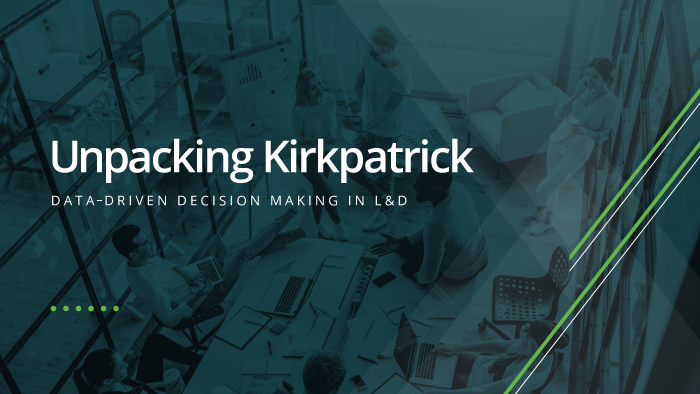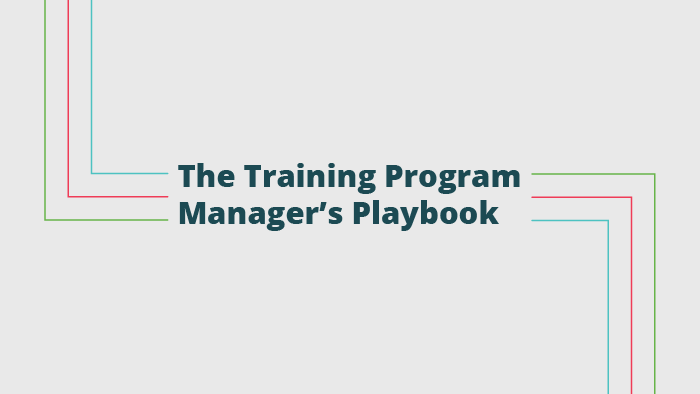For program managers, measuring the results of training is often overlooked, despite being a crucial component of the training process.
If you’ve looked into evaluating training or improving the way you’re currently evaluating training, you’ve undoubtedly stumbled across the Kirkpatrick Model during your research.
In case you haven’t, here’s a quick overview:
There are four levels of evaluation in the Kirkpatrick Model, and each level progressively informs program managers how successful a training event or initiative has been.
Reaction – Level 1
In the reaction level, it’s your job to evaluate the response from learners – specifically, how they felt about training.
Learning – Level 2
At this level, you’ll need to measure how effectively the information was absorbed by your learners. Typically this is done through testing.
Behavior – Level 3
In this level, you’re measuring the degree to which your training has influenced the behavior of the participants, and how they are applying their new knowledge to their jobs.
Results – Level 4
At this level, you’re measuring the impact your training event has had at the business level, and getting a clear sense of ROI for your training program.
If you’re looking for a deep dive into using the Kirkpatrick Model for evaluating training in your organization, download our free ebook here:
Keep reading to learn how to use this model to determine the effectiveness of your training!
Start With the Results You Want to See in Level 4
When you go on a road trip, you don’t just get in your car, start driving, and hope you get to your destination – you first identify your destination, plan how you’ll get there, where you’ll stay overnight, and what you’ll do when you get there.
Training should be the same way – you don’t want to simply launch a program without first aligning your training to a desired result.
The result you identify should be tied to a business goal of some sort – whether it’s employee retention or sales growth, identify where you want to be, and you’ll be better prepared to make a plan for how to get there.
Identify the Behavior You Want to Change With Level 3
When you’ve identified what result you want, the next step is to identify the behaviors that will influence that result.
Let’s say you want to increase your client retention – what behaviors do you think will contribute to increasing that client retention?
Maybe you believe employees need to do more small, thoughtful gestures to help clients feel appreciated, or it could be that clients need more product training so they can get more value from your solution.
Work with managers and stakeholders to identify behavior changes – the only way to get to your desired result is by identifying and changing the behaviors that influence your results.
Create a Training Initiative Aligned to Your Behavior Changes and Desired Outcome in Level 2
If you haven’t noticed by now, we’re running through the Kirkpatrick levels of evaluation in reverse – we started at Level 4 with results, then moved to behavior at Level 3. So now let’s look at Level 2, which is learning.
Here, you’ll identify training and resources you can put together to change the behavior that influences the outcome.
What learning strategy makes the most sense? Video only? On-the-job training? Blending instructor-led and online content?
We recommend only settling on a strategy when you can identify a reason why you’ve chosen that strategy.
Determine How You’ll Measure Reaction for Level 1
The final step in the planning phase is to determine how you’ll measure the response to your training.
The easiest way to do this is through testing, but you can also use data collection methods like surveys or interviews – pick an approach that works for your learning strategy!
Implementing the Kirkpatrick Model Step-by-Step
The Kirkpatrick Model isn’t just a method of training evaluation, it’s a framework you can use to guide your training process, and tweak training initiatives based on the real data you have.
Now that you’ve used the Kirkpatrick Model to create your training plan, the next step is to implement that plan!
We’ll start with data collection and evaluation through the training event.
At this stage (Level 1) we’ll start by measuring how employees felt about the training event.
When recording Reaction (Level 1), keep in mind:
- Surveys and interviews are a good way to capture reaction, but make sure you take precautions to avoid bias. For instance, employees may feel pressured to report more positively on training if their responses aren’t anonymous.
- Just because employees didn’t react positively to your training doesn’t mean it was ineffective – continue measuring results!
Next, we’ll measure how well employees retained what they learned. We can do this through evaluation.
The better employees do on post-training evaluation and reinforcement initiatives, the more effective your training.
When measuring learning (Level 2), keep in mind:
- Prior to implementing training, identify key learning points that you believe will lead to behavior change.
- Build your testing process around understanding of these key learning points – don’t focus on memorization of extraneous details if they’re not important for the long-term.
- The learning phase is about creating a behavior change in your learners.
In Level 3 of training evaluation, you can look at the behavior changes that came about as a result of your training.
This is mainly measured observationally. In your planning phase, you may want to discuss with stakeholders what behavior changes you’re hoping to affect, and how to observe them.
When measuring behavior (Level 3), keep in mind:
- Work with stakeholders, and teach them to identify, observe, and record behaviors that you want to change both before and after the training event.
- The behavior change should ideally lead to a change in outcome. If it doesn’t, you may have identified the wrong behavior.
Here’s where the Kirkpatrick Model really starts to shine – it provides real-time feedback for your training process.
If behavior changes aren’t happening, but tests results indicated that training was effective, you can reasonably deduce that more training is necessary, or perhaps the training could be better aligned to the behavior change.
While the Kirkpatrick Model won’t give you an exact diagnosis of issues in your training program, it will help you determine where disconnects could be occurring.
Finally, in Level 4, you can measure results.
Use the same measurements you’ve used before your training event and compare the results. With enough analysis, you can get reliable and accurate ROI information from Level 4.
Kirkpatrick in Action: A Case Study
We put together a useful case study, so you can see the Kirkpatrick Model in action.
Follow along with this example, and you’ll have a better idea of how to approach your own training program with measurement and ROI in mind!
In the planning phase, we turn the Kirkpatrick Model upside down and start at the end – by identifying the results we want to see.
In our case study, our organization isn’t growing revenue at the rate we’d like to see. We want to increase sales revenue, so we know what result we’re looking for: a significant (more than 10%) increase in the rate of new revenue growth.
Next, we must identify the behavior that needs to change before we achieve our desired result.
To identify this behavior, we talk to our sales leaders, and ask about KPIs they use to track success. What we discover is that our sales agents are closing deals at the rate we need them to, and they’re closing them at the speed we need to – however, they’re not having enough conversations with qualified prospects.
After discussing the issue with some of our top-performing sales reps and sales leaders, we decide that our sales reps need to learn to qualify prospects better, so that we can increase the number of sales conversations the average rep is having.
The behavior we’ve identified in this step is improving the way your sales reps qualify prospects over the phone.
The KPIs for this behavior are length and quality of conversations, and the number of prospects moved through the sales process.
Next, the Kirkpatrick Model asks us to identify learning that ties to the behavior we’re trying to change.
So we logged into our LMS to find learning content on this topic, and found this Sales Toolkit had several relevant videos to use.

We now have a curriculum to develop around, and we develop a blended approach to teach these new skills to our sales reps.
We only have one more step before we’re ready for the training event – deciding how to capture reaction.
We come up with a brief survey using a Likert scale to determine how learners reacted to our training.
It looks like this:

Now we’re ready to start training! We execute the plan we made in our learning stage and use the Kirkpatrick Model to measure our results.
First, immediately following the training event, we use our Likert scale to gauge reaction. We learn that on average, employees felt “satisfied” with the content, “very satisfied” with the relevance to their job, and ”neutral” toward ease of understanding key concepts.
Overall, employees scored an average of 86% on post-training testing.
After discussing behavior changes with stakeholders, you believe your training has led to significant behavior changes, and the results speak to that; qualified prospects have risen by 34%, bringing your revenue growth rate up by 12% from the prior month – these are numbers you can reasonably attribute to your training efforts!
Just like that, the Kirkpatrick Model helps you identify and report on specific changes in your organization, and with the right data, you can measure an accurate and reliable ROI for training!
The Kirkpatrick Model is a proven framework to follow for training evaluation, and for understanding all the ways that investing in training affects costs and revenue across the organization.
By following it, you can improve the way you plan for, implement, and measure training.


